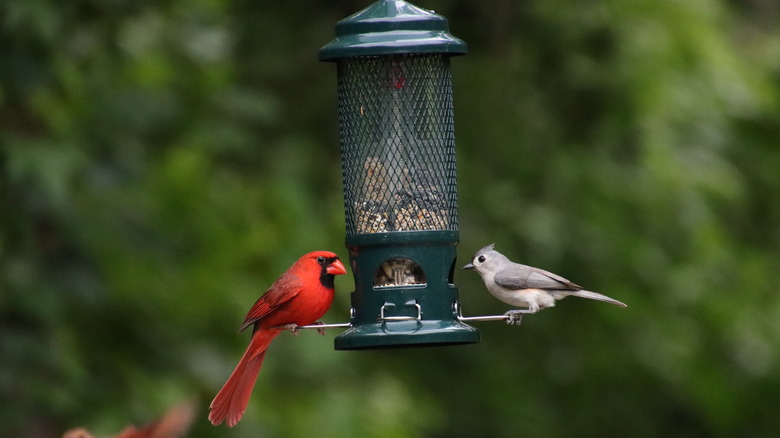Keep Snakes From Slithering Into Your Yard By Ditching This Popular Feature
If you're an avid bird watcher, a bird feeder in your garden offers many benefits, beyond being a delightful way to attract a variety of feathered friends. However, what you might not realize is that this seemingly harmless addition can inadvertently attract unwanted guests, such as snakes. It's a classic case of the food chain in action right in your backyard. Bird feeders, while designed to feed birds, end up feeding more than just our avian companions. The issue arises when birds, perched on the feeder, scatter seeds and other food items on the ground. This debris becomes an open invitation for rodents like mice and squirrels, who are drawn to the easy meal.
Now, where there are rodents, snakes often follow, as the small mammals form a significant part of their diet. Thus, your well-intentioned bird feeder could be turning your garden into a prime hunting ground for snakes. The dilemma here is clear: you want to enjoy the birds but not at the expense of turning your garden into a snake haven. One solution might be to remove the bird feeder altogether. However, if you're not ready to give up on your birdwatching activities, there are ways to maintain your bird feeder while minimizing its attraction to rodents and, consequently, snakes. You'll need to consider the timing of feeding, ensure you carefully choose the feeder's location, and select a design that reduces spillage. It also helps to first understand the behavior of both the birds and the visiting rodents.
Ensuring proper feeding and placement of your bird feeder
To manage your bird feeder effectively and keep rodents and snakes at bay, strategic feeding is essential. Birds are most active in the early morning, so this is the best time to add food to your feeder. It's important to provide only as much food as the birds can eat by evening. This method ensures that there are no leftovers to attract nocturnal rodents, such as rats, which in turn attract snakes. The placement of your bird feeder also plays a crucial role in preventing rodent access. Hanging it near low branches or structures makes it easier for rodents to reach. To avoid this, choose an open and elevated location for your feeder. The higher the placement, the more challenging it is for ground-dwelling rodents to get to it. This elevation not only makes it difficult for rodents but also makes the feeder a safer and more peaceful spot for birds.
Additionally, the design of your bird feeder can significantly reduce spillage and the subsequent attraction of rodents. Feeders with catch basins or designs that limit spillover are particularly effective. An example is the SquirrelBuster, known for its efficient design in minimizing seed spillage. This type of feeder helps to ensure that the food intended for birds does not end up feeding rodents.
Implementing other rodent-proofing measures
Beyond the strategic placement of your bird feeder, there are additional steps you can take to deter rodents. One interesting tactic is to use bird feed that incorporates pepper oils. These oils deter rodents due to their spicy nature, but they are perfectly fine for birds. Additionally, surround your feeder with strong-smelling leaves like mint, eucalyptus, or citronella. These natural scents repel rats and other rodents. It's crucial to refresh these leaves regularly to ensure they maintain their potency and continue to be an effective deterrent.
Another important step is to clear the foliage beneath your feeder. Overgrown bushes, piles of leaves, and debris are ideal hiding spots for rodents. An open and well-maintained space exposes them, making your garden less attractive as a potential nesting area. This not only discourages rodents but also snakes, which may be attracted to areas where rodents are present. Also, don't overlook the importance of regular cleaning. If you use a tray under your feeder to catch stray seeds, be diligent about cleaning it out regularly.
Lastly, you can consider using a baffle to outsmart rodents. This is a smooth, slippery cone-shaped cover that you place either above or below the feeder on the same pole. Its main job? To make it super tricky for rodents to climb up to your feeder. They try to get a grip, but whoops — the baffle's smooth surface means they slide right off. It's a really effective way to keep those pesky critters from raiding your bird feed.


